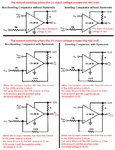danny davis
Banned

- Joined
- Mar 1, 2013
- Messages
- 627
- Helped
- 0
- Reputation
- 0
- Reaction score
- 0
- Trophy points
- 1,296
- Location
- Hollywood
- Activity points
- 0
How do you know which Polarity has the Hysteresis? it is always the negative polarity that has the hysteresis?
If a comparator or op amp has hysteresis, how would a tech know the hysteresis is not working? when testing the inputs and outputs?
- - - Updated - - -
Bench Check Tests I do when testing comparators in the circuits , I'm guessing there is different types of Hysteresis
Hysteresis TYPE#1
1.) Raise the Positive voltage up until you FIND the threshold switching point, the output switches states to a HIGH
2.) Lower the Positive voltage down until you FIND the threshold switching point, the output switches state to a LOW
The Positive voltage going up will have a different threshold switching point voltage and current than the positive voltage going down
You turn the trim pot up until you find the threshold switching point, you turn the trim pot down until you find the threshold switching point
This will change the output state from HIGH to LOW
But the Positive voltage going up will have a different threshold hold switching point value than than the positive voltage going down
The positive voltage going UP will switch at +5 volts
But the Positive voltage going Down will switch at 1 volt
How does the Hysteresis do that?
I would think it would switch at +5 volts going UP and going DOWN , not at two different voltages
Why is that and how does the hysteresis do this?
It seems that the Positive voltage going UP doesn't have the Hysteresis ONLY the Positive voltage going Down?
What Hysteresis is this type called ? is this the positive feedback one?
Hysteresis TYPE#2
1.) Raise the Positive voltage up until you FIND the threshold switching point, the output switches states to a HIGH
2.) Flip the Polarity to a Negative voltage ( - ) and raise the voltage until you FIND the threshold switching point, the output switches states to a HIGH
It seems like there is Two different Hysteresis , one for each Polarity?
Because the Positive voltage will switch at + 5 volts
and the Negative voltage ( - ) will switch at -3 volts , I would think it would be at - 5 volts
But this output only goes to a HIGH state not a low state , either polarity positive or negative
What Hysteresis is this type called ? is this the positive feedback one?
If a comparator or op amp has hysteresis, how would a tech know the hysteresis is not working? when testing the inputs and outputs?
- - - Updated - - -
Bench Check Tests I do when testing comparators in the circuits , I'm guessing there is different types of Hysteresis
Hysteresis TYPE#1
1.) Raise the Positive voltage up until you FIND the threshold switching point, the output switches states to a HIGH
2.) Lower the Positive voltage down until you FIND the threshold switching point, the output switches state to a LOW
The Positive voltage going up will have a different threshold switching point voltage and current than the positive voltage going down
You turn the trim pot up until you find the threshold switching point, you turn the trim pot down until you find the threshold switching point
This will change the output state from HIGH to LOW
But the Positive voltage going up will have a different threshold hold switching point value than than the positive voltage going down
The positive voltage going UP will switch at +5 volts
But the Positive voltage going Down will switch at 1 volt
How does the Hysteresis do that?
I would think it would switch at +5 volts going UP and going DOWN , not at two different voltages
Why is that and how does the hysteresis do this?
It seems that the Positive voltage going UP doesn't have the Hysteresis ONLY the Positive voltage going Down?
What Hysteresis is this type called ? is this the positive feedback one?
Hysteresis TYPE#2
1.) Raise the Positive voltage up until you FIND the threshold switching point, the output switches states to a HIGH
2.) Flip the Polarity to a Negative voltage ( - ) and raise the voltage until you FIND the threshold switching point, the output switches states to a HIGH
It seems like there is Two different Hysteresis , one for each Polarity?
Because the Positive voltage will switch at + 5 volts
and the Negative voltage ( - ) will switch at -3 volts , I would think it would be at - 5 volts
But this output only goes to a HIGH state not a low state , either polarity positive or negative
What Hysteresis is this type called ? is this the positive feedback one?


